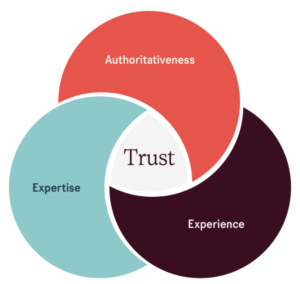Why do some websites appear on page one of search engine results while others don’t? The solution is complex and changes constantly. But if we were to simplify it, the algorithm would be at the centre of everything.
Each search engine builds its own settings to control what appears on the first SERP (search engine results page). These variables (or algorithms) fluctuate slightly every day. And they’ll occasionally change significantly, which will cause everyone to adjust their marketing plans in response.
Let’s travel back in time to the beginning of the Internet, shall we? Early algorithms relied on straightforward criteria like keyword density. People could create websites that appeared on the first SERP by using the same term more often than any other page (and occasionally without offering the visitor anything of genuine value).
This practice, known as Black hat SEO, is a form of SEO method that might harm your website’s reputation. The extra cunning people would write the same keyword thousands of times and hide them by making the font colour the same as the background.
Google disapproved of this keyword-stuffing technique and established keyword density guidelines after users complained that they were directed to spammy pages that did not answer their queries. This eliminated keyword-stuffing spam (or, at the very least, punished the websites that adopted the tactic). But the search for quick, simple solutions to rank without adding genuine value never ended.
To give users who seek “authoritative and trustworthy” content a better user experience (UX), Google adjusts its algorithm annually. And aren’t we all like that? Building content and websites utilising SEO-recommended practices increases your likelihood of appearing on the first SERP.
There are numerous variables to consider when determining how websites rank in Google search results. These can include the technical elements of a website, such as its code and structure, or how the information is arranged on a page. In this blog article, we’ll concentrate on “Google E-E-A-T” and what it means for content in 2023.
HOW DO WE KNOW WHAT IS GOOGLE LOOKING FOR?
The best practices are outlined in papers, manuals, videos, podcasts, and Google’s press releases. Although unsure of the exact formula, we are knowledgeable enough to make informed marketing choices. In addition, another “E” was added to the “E-A-T” in the quality rater criteria in Google’s most recent E-A-T upgrade.
WHAT IS E-E-A-T?
The acronym “E-E-A-T” stands for “Experience, Expertise, Authoritativeness, and Trustworthiness.” It is a collection of standards that Google’s search evaluators use to judge the reliability and value of websites. The E-E-A-T-ness of your website will impact your page quality score and positioning.
These E-E-A-T principles’ main objective is to gauge trust. According to Google, trust refers to “how accurate, honest, safe, and reliable the page is”. Furthermore, credibility is established by authority, knowledge, and experience.
Here is the illustration Google provided to illustrate this idea:
The rules are founded on the idea that trustworthy websites include authors (and other experts) with a track record of expertise and experience in their industry. These websites are reliable and give consumers access to up-to-date information.
Let’s see how to add these components to a website.
EXPERIENCE
Experience indicates that the web page’s author has firsthand knowledge of the subject and a thorough understanding of it.
Google has the following to say on the value of experience:
“Many types of pages are trustworthy and achieve their purpose well when created by people with a wealth of personal experience. For example, which would you trust: a product review from someone who has personally used the product or a ‘review’ by someone who has not?”
You may be trying to find techniques to pick up speed if you’re preparing for a marathon. This doesn’t necessarily imply that you want personal trainer content. Expertise is essential, but there are instances when personal experience is more approachable and beneficial. As a result, you might come upon a blog where someone is writing about their marathon experience. They might discuss their training regimen or what they wish they had done differently in their writing.
If your company cleans people’s homes, you may provide a before-and-after image of a dirty refrigerator you cleaned to demonstrate experience. You describe your cleaning procedure and name every environmentally friendly product you used in the content. This strategy may be more accessible to website visitors than a straightforward how-to manual because they know this was their own personal experience.
EXPERTISE
Expertise is the possession of specialised knowledge and abilities on a certain subject. Different topics call for various types and degrees of competence.
You should opt for a financial advisor or a professional with an accounting degree or equivalent expertise if you need investing counsel. On the other hand, you should look for someone with knowledge of fitness and exercise, such as a certified personal trainer, if you want guidance on what kind of exercise plan to follow. The degree and kind of skill required varied in the two situations.
Here are some strategies for showcasing knowledge on your website:
- Include a bio or “About Us” page that details the content creators’ qualifications, training, and relevant job experience. Include any accolades or certificates they have earned proving their know-how in a certain area.
- Share thorough case studies illustrating the website’s subject-matter knowledge.
- Share any articles, whitepapers, or research projects the content creator has contributed to regarding research and publications.
- References and links to books, journals, and other sources supporting the website’s authority should also be included.
AUTHORITATIVENES
You should be recognised as the go-to source for the subject on your website and elsewhere to establish your authority. This indicates that people regard your website as dependable, trustworthy, and an industry leader.
The Mayo Clinic, a highly regarded and well-known medical institution, is an example of a reliable website. For accurate and trustworthy information on health and medicine, turn to this website. Because of its standing, track record of producing top-notch content, and staff of knowledgeable writers who are acknowledged authorities in various professions, it is regarded as an authoritative source in the field of medicine.
External recognition, such as accolades, press attention, or recommendations from renowned organisations, is one approach to showing authority. Another way is through internal indicators, such as a group of subject-matter specialists or a lengthy record of generating top-notch literature on the subject.
Furthermore, exhibiting case studies or client testimonials can support the assertion of authority.
TRUSTWORTHINESS
A website’s ability to demonstrate its reliability as a source of information can be demonstrated by its experience, competence, and authoritativeness. These three components may also overlap.
For instance, having extensive hands-on experience in a particular field can indicate that a person thoroughly understands the subject, which can show their expertise. A person with extensive knowledge and expertise in a certain sector may also be regarded as an authoritative source.
Even though a webpage is supported by a great deal of experience, knowledge, and authority, it won’t be regarded as a high-quality page if it lacks trustworthiness. For instance, even if a website offering medical advice provides precise and trustworthy information, the website won’t be regarded as high-quality.
HOW GOOGLE MEASURES E-E-A-T
Google gauges E-E-A-T by analysing the data that the website or content publisher has provided. Google also searches for unbiased evaluations and sources, including news stories. Reviews won’t be taken seriously if there is a conflict of interest.
If you say, for instance, “our product is great,” that statement is not as credible as one from a consumer who says, “their product is great.” Your page will have a low E-E-A-T score if it appears unreliable for any reason.
The quality of each page is rated on a scale from lowest to highest.
Misleading, spammy, or dangerous pages receive the lowest page quality rating. Poor-quality pages fail to fulfil their intended function. Although some low-quality pages might be missing crucial components, they might not be misleading or harmful. A low-quality page can, for instance, provide an answer while having an excessive number of pop-ups that detract from the user experience. Or a website may be fascinating or useful, but its information may not be complete or reliable.
Although they may not be flawless or contain all the elements of high-quality pages, medium-quality pages nonetheless offer helpful information or perform a particular purpose.
The best pages have the best goals, designs, and user experiences. They are regarded as the best and distinguish themselves via their extraordinary quality and meticulousness. The high-quality page grade is given to well-designed, educational pages that offer a satisfying user experience. These pages can be used for various topics and objectives, such as informational purposes, product sales, amusement, and creative expression.
HOW DOES E-E-A-T AFFECT SEO?
Google aims to ensure that the data users discover through Google Search is reliable and accurate. This is crucial for subjects that greatly impact people’s health, safety, economics, and general well-being.
Websites that exhibit the appropriate level of E-E-A-T for their topic will therefore have a higher chance of appearing high in search results. Google also advises website owners to self-evaluate their content using the E-E-A-T criteria.
Even while it all seems technical, it’s really just common sense. These recommendations focus on user experience and providing factual information to your website’s users, not only ranking.
Consider the last time you used Google to look up a solution to a dilemma or a response to a query. You presumably clicked on a link hoping to find experience, competence, authority, and integrity. Because of this, these are the same components you should offer on your website.
Conclusion
By improving E-E-A-T, you can improve your page’s quality rating. This will, in turn, improve your Google ranking over time. You can use several strategies to improve E-E-A-T, which we will discuss in the next blog article. In the meantime, if you want to improve your web page’s quality without learning about E-E-A-T, contact us here. Our team of experts are happy to help!












